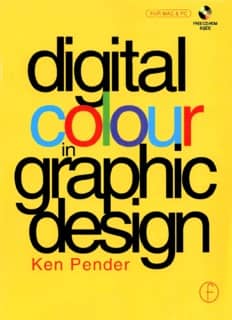‘Digital Colour In Graphic Design’ PDF Quick download link is given at the bottom of this article. You can see the PDF demo, size of the PDF, page numbers, and direct download Free PDF of ‘Digital Colour In Graphic Design’ using the download button.
Digital Colour In Graphic Design PDF Free Download

Digital Colour In Graphic Design
Diagrams are the principal tool used in color specification today. However, there is increasing use of the CIE 1976 chromaticity diagram, which is a nearly identical version.
A discussion is presented in which the latter is presented. The text relating to the particularly important OSA Uniform Color Scale has been expanded and is now a chapter in its own right (Chapter 9).
Diagrams are provided to identify both identical color scales and identical two-dimensional color arrays in the OSA scheme. The CIELUV and CIELAB color spaces hold similar potential value in art and design.
Both of these are discussed in more detail (Chapter 8). The number of sections has been expanded in Chapters 7 and 8, and the following new topics have been introduced: Iridescence Kolote (Liquid Asphalts), Metameric illumination, Color rendering of the German standard color chart.
and two taupe color samples Chroma Cosmos 5000, Chromatin 707). Dance was not included in the Swedish NCS notation scheme in the first edition of this book, the revised notation is presented here.
In the introduction to the previous edition, the names of contemporary color scientists who have made technical contributions in particularly relevant areas to art and design are given.
Not surprisingly, since then I have learned of other major contributions. And. If I tried a twist. I am afraid that this too will be insufficient. Now for artists and designers to better appreciate the vast advances in color science,
In preparation for the Tiles Tew edition Tvend, aid in the discussion of the later images in Chap. 11 The afterimages belong to complementary pairs.
These types of complementary colors were considered by Goethe in his color studies and were often used by artists in the past.
Its rays can be assumed to be parallel upon arrival and of equal intensity at short, terrestrial distances.
Of course, this is not true of room lighting – an example being a class of lights known as ‘omnilights’ – which emit light radially in all directions, the intensity of which diminishes with the square of the distance between the light source and the illuminated object.
Dramatic effects can be created in graphics using light from simulated spotlights that are directional and variable
intensity.
When light strikes the surface of an object, some of the light bounces back from the surface by reflection.
The remainder of the light is transmitted (absorption) or through the material (transmission).
If the surface of the object is smooth, then the angle of reflection is equal to the angle of incidence (specular reflection).
If the surface is rough, the reflected light goes in all directions (diffused reflection).
Shadow and reflection can be considered as the inverse of light.
The surface of an object that gets away from direct light, receiving only reflected light from other surfaces, is called shadowed.
Shadows arise when an opaque object blocks light from reaching a surface that would otherwise be illuminated.
In the real world, objects are illuminated by direct sunlight, light reflected from neighboring objects, and light scattered by dust and other particles in the atmosphere, producing complex results that are not easy to predict.
The sum of all these sources of background lighting is commonly referred to as ‘ambient’ lighting.
Before creating graphics that attempt to simulate real-life scenes, careful study of photographs can be a source of useful guidance.
| Writer | Ken Pender |
| Language | English |
| Pages | 225 |
| Pdf Size | 34 MB |
| Category | Art |
Digital Color in Graphic Design Book Pdf Free Download
